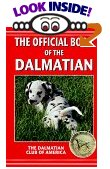Healthy Living
Good News. At the grand old age of 9½ and to the mild surprise of our Vet, Rolf is still alive and well, and bouncing around the park. To celebrate, Iíve added a new section named; "Health".
We've been blessed with Rolf, though he may not think the same of us. He suffers none of the genetic weaknesses that are common amongst Dalmatians. Since we inherited Rolf we have had a steep learning curve, and I shudder to think of the mistakes we've made along the way, and how well-meaning ignorance might have spelt disaster for a different Dal. 'The Official Book of the Dalmatian' has been added to my recommendations. It has been researched, compiled, and written by a number of esteemed members of the Dalmatian Club of America. It is an encyclopaedic resource for every Dalmatian owner, and I wish for Rolf's sake, I had learned of it years before now. I mention this again elsewhere, and link to a few priceless resources on the DCA web site.
One of the biggest shocks I had as a new Dalmatian carer was this: Not all dog-food is Dalmatian food. The first article in the health section is about kidney stones. The Dalmatian is generally susceptible to these because of the way it handles purines. Purines are substances that exist in most foods to a greater or lesser extent. A diet rich in purines will kill some Dalmatians.
You may have noted that Rolf has a small amount of sardines in his diet, yet sardines are very high in purines. Genes, gender, and diet in general, are all factors in whether your Dal will develop kidney stones. Some Dalmatians are more vulnerable than others, so donít add sardines to your Dal's diet just because I do. Get more information here: "Health: Kidney stones".
Kidney Stones
Dog food isnít Dalmatian food.
Pretty much all food derived from plants, animals or fish contains amounts of a group of chemicals called purines. When ingested, most mammals break these purines down into a water-soluble chemical called allantoin, and pass this harmlessly out of their bodies in their urine. The bad news is that Dalmatians are different.
Dalmatians only get part way to turning purines into allantoin. For other mammals, uric acid is produced as an intermediate step in the transformation of purines to allantoin. In Dalmatians, this is where it stops. Dalmatians must excrete the uric acid in their urine. In some Dalmatians this doesnít happen the way it should.
Uric acid doesnít dissolve in water as easily as allantoin, so when it is washed out of the kidneys its molecules can bunch together forming small crystals or 'stones'. These stones often remain small enough to pass out of a Dalmatians body, but for some Dals they hang around in the bladder and urinary tract, getting bigger, and dangerous.
If your Dalmatian has difficulty urinating, get them to the Vet quickly. If stones are blocking your Dalmatians urinary tract, this is life threatening.
Read more:
The Dalmatian Club of America (DCA) is rightly proud of its core publication ĎThe Official Book of the Dalmatianí. Itís relatively expensive, but possibly the only Dalí book youíll every need (and I bet youíve got it already). Otherwise use this link to buy it at Amazon.
Info links:
The DCA is funding research into Dalmatian kidney stones at The University of Tennessee, College of Veterinary Medicine. We can give them a hand with this on-line survey. The DCA has published a table of dietary purines here and have more info and links about kidney stones here.
I found this page about 'uric acid stones' at the Mar Vista Animal Medical Center very useful.
22nd May 2004Moving
Rolf's change in his internet home has coincided with a bricks-and-mortar change in his earthly home and I'm afraid that it's all been too distressing for him.
For humans, moving home is the most stressful experience after bereavement and divorce. It seems to have taken its toll on Rolf as well. In the last weeks the old house had been full of strangers (estate agents, surveyors, buyers, removals people) which had a notable impact on him as a social/pack animal. Additionally, he seems to have a phobia about being abandoned after a house move when he was a pup went pear-shaped.
After the move, one morning we noticed that he was stiff and shaking, and in pain if he exerted himself. The Vet told us he had a grade 5 heart-murmur, and I got the feeling she didn't expect to see him again alive. Rolf's had a malfunctioning heart valve since suffering Kennel-cough in his early years, but seems to have kept going regardless. We have added a Flaxseed/Linseed oil capsule to his reinstated, normal diet and he seems to be better.
I'll update you with news before the end of the month.
7 May 2004

 Dalmatians (Complete Pet Owner's Manual)
Dalmatians (Complete Pet Owner's Manual) The Official Book of the Dalmatian
The Official Book of the Dalmatian